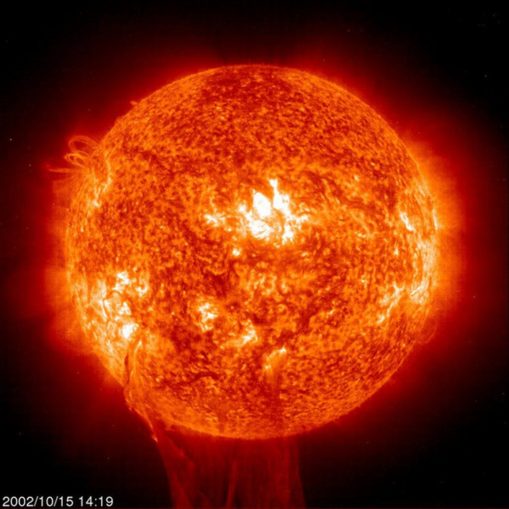
SOHO (ESA & NASA)
Ask anybody about the workings of the Sun and some will say that it relies on nuclear fusion for its energy output and there will be nods of agreement and then the conversation will turn to what nice teeth that wonderful Mr. Cox has and isn’t Stargazing live the best television ever apart from the need for Dara OBriain to make poor jokes. But is there more to the operation of the Sun? Well of course there is but it’s not so straightforward so here’s a brief explanation of some of its working.
Let’s move back to what the Sun really is. It’s a large cloud of hydrogen that is trying to crush itself owing to gravity – the gravitational attraction of each hydrogen atom attracting each other – and this is countered by pressure within the gas. This pressure being created by the conversion of gravitational potential energy on the gas to heat, which, if it’s high enough, causes a rise in the kinetic energy of the hydrogen particles that then leads to nuclear fusion at about 106 K
Well, yes, mostly. You see, only about a third of the Sun’s energy comes from nuclear fusion whilst a good part of the deficit comes from conversion of gravitational potential energy to kinetic energy and the inability for this energy to exit the star owing to its opacity. This means that stars are hot which enables fusion rather than fusion making them hot.
This is typical of physics, it isn’t quite what we thought it was. But it gets a little more weird than that.
The Sun, as we’ve seen, is a pretty hot place. This means that hydrogen (and usually some helium ) is ionised, that is to say, the atoms have so much energy that the electrons have long since left and bounce around independent of their nuclei so each hydrogen atom can be considered to consist of an electron somewhere in the star and a separate proton. We accept that fusion is the ramming together of (for the sake of brevity) 2 protons to create a new nucleus but there’s a difficulty. Both protons are positively charged and so will naturally repel. This electrostatic or coulomb force needs to be overcome to enable the protons to get to within 10−15 m of each other where another force, the strong nuclear force, can take over and bring the two protons together so that they can fuse.
Problem.
The mean, modelled temperature at the core of the Sun equates to a proton energy value of 1.3keV whereas to overcome the coulomb barrier, we need around 1.3mev. This means that we are out by a factor of a thousand. So how the hell do protons manage to fuse?
If we consider a proton trapped in a well where the height of the walls are the same as the coulomb barrier (1.3 meV) then the particle can only escape once it has the same amount of energy. It doesn’t so it can’t but what about if it could move through the wall of the well?
All matter exhibits a wave like behaviour, from a single electron to larger molecules and possibly beyond, each has a wavelength depending on its mass an momentum. This wave/particle duality was initially thought to only be relevant to light but has now been proven to hold for all matter (look up electron diffraction for further reading). This wave function (part of Schrodinger’s equation) has a number of parts however, the square of the spatial part of the wave defines something very important, that is, the position probability density. In other words, there is a probability of a particle being outside of what we would consider its physical position – this is quantum mechanics so for the sake of your sanity, please just accept it for now.
As the particle or proton can exist slightly outside its physical location, protons can, theoretically, tunnel their way through the wall of the well mentioned earlier. This quantum aspect means that they would require less energy to overcome the coulomb barrier that classical physics theory insists is necessary.
Is it true?
Yes. Barring very random protons having sufficient energies through collisions, there is no other method of nuclei fusing in our Sun given the kinetic energies of each proton however the chances of tunnelling is still small with a penetration probability of around 10−10 − 10−60. This is not completely surprising when you consider that the collision to create a fused particle has a cross-sectional areas of the order of 10−30 m. So, going back to where we started, fusion accounts for ~ 300w/m3 of the Sun and it should be considered that the function of fusion in our Sun is simply to top up the radiation pressure to ensure hydrostatic equilibrium which ultimately defines how the star will age and its total lifetime.
This has been severely condensed so please be kind, I know I’ve had to leave lots out and abridge much!
© Rat Catcher 2017



